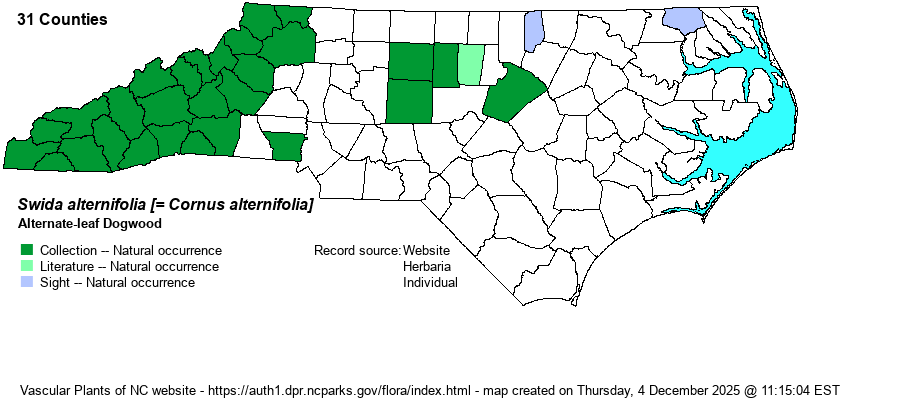| Author | (Linnaeus f.) Small | |
| Distribution | A bimodal range in the state. It occurs throughout the Mountains and into the western Piedmont foothills. It then is disjunct to sites in the eastern Piedmont (Guilford and Randolph counties east to Wake and Vance counties). There is a sight record for Gates County in the northern Coastal Plain. It appears to be genuinely absent, if not very scarce, in most of the Piedmont.
This is a very widespread species across southern Canada and most of the eastern U.S., though it ranges mainly south in the Appalachians to northern GA and AL. In the Piedmont and Coastal Plain of the Southern states, it is very widely scattered, mostly in AL.
| |
| Abundance | It is fairly common to common in the Mountains, locally fairly common in the Piedmont foothills, but is rare and local in the lower Piedmont and close to the VA border farther to the east. It seems to be truly absent in many or most central and southeastern Piedmont counties. | |
| Habitat | This is a dogwood of rich soil. Favored habitats are cove forests, moist hardwood forests near and along streams, and wooded stream banks. Though not restricted to circumneutral soils, it does require moist and fairly rich (often acidic) soils, but it is not a wetland species. | |
| Phenology | Blooms in May and June; fruits in August and September. | |
| Identification | This is a medium to large shrub, rarely to small tree size, usually with a single trunk; it normally reaches to about 10-12 feet high, and often broader, with a very conspicuous horizontal “layering” of the branches. The deciduous leaves are typical of those of other dogwoods – widely elliptic, entire, and about 3 inches long, with several strongly parallel veins coming off the mid-vein of a leaf and curving toward the margins. However, this is our only dogwood with non-opposite leaves. It does have branches that come off larger stems alternately, but most of the leaves tend to be clustered toward branch tips and are not easy to see as being alternate. Most people can identify this species by the horizontal layering of branches and by the alternate branching, but others may need the broad and flat clusters of small white flowers to clinch the identification. The numerous fruits are blue in color. | |
| Taxonomic Comments | Weakley (2020) names this genus as Swida, following recommendations of several recent references.
| |
| Other Common Name(s) | Pagoda Dogwood. The species is frequently named as Alternate-leaved Dogwood. This website and many others try to avoid the “-ed” suffix in species names, as the “-ed” is added to a noun that is turned (sometimes awkwardly) into an adjective by adding the “-ed” ; i.e., the site prefers “Roughleaf Dogwood” (or “Rough-leaf Dogwood”) to “Rough-leaved Dogwood”. | |
| State Rank | S4 | |
| Global Rank | G5 | |
| State Status | | |
| US Status | | |
| USACE-agcp | | |
| USACE-emp | | |

